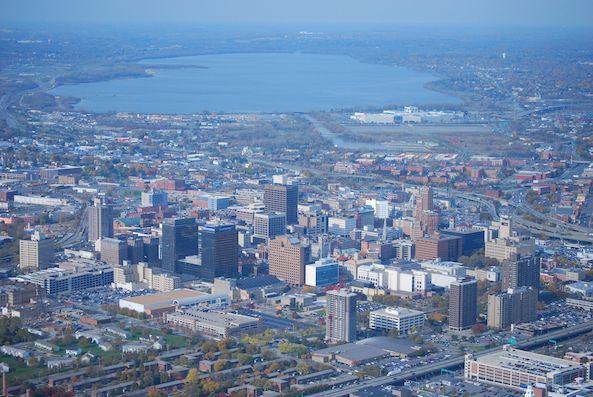
Onondaga Lake
| Status | Threatened |
| Country | United States |
| Report By | Callie Shanafelt Wong |
| Thanks | Oren Lyons, Robin Kimmerer |
| Posted | May 17, 2022 |

Centuries ago, the Mohawk, Oneida, Onondaga, Cayuga and Seneca were warring with each other in lands extending from what is now known as central and western New York, south into Pennsylvania, and east to Montreal, Canada. In what’s now Syracuse, New York, lies a beautiful lake that was full of fish, pristine water and natural salt deposits. One day, a Huron man came with a message from the Creator intended to teach these nations the way of peace. For years he traveled from village to village sharing his teachings, gathering supporters—including Hiawatha—along the way. Once they had peace in their hearts, he gathered representatives from the five nations around a large white pine on the shores of the lake and tied five arrows into one bundle to represent the unity of the five nations.
The people bound themselves together in the Haudenosaunee Confederacy and the man became known as the Peacemaker. To this day the people of the Haudenosaunee Confederacy follow the lessons and teachings of the Peacemaker. As Onondoga Faithkeeper Oren Lyons says, ”It’s always about peace and it’s always about equity and it’s always about respect and it’s always about nature.” Onondaga Lake and the Tree of Peace became a sacred site for the Haudenosaunee. But when Europeans came, they did not respect the ways of the Peacemaker. They stole the land, broke treaties, and as capitalism took hold, they polluted the sacred lake to the point that it is now considered the most polluted lake in the United States and one of the most polluted lakes in the world.
The Land and its People
The oldest participatory democracy, today the Haudenosaunee Confederacy is made up of the Mohawk, Oneida, Onondaga, Cayuga, Seneca and Tuscarora. Their alliance is outlined in The Great Law of Peace. Members of the Haudenosaunee Confederacy strive for balance between law, society and nature. Each nation within the Confederacy has its own unique culture. The Onondaga strive for the right relationship with nature. Every gathering is opened with the Thanksgiving Address, or Ganoñhéñ•nyoñ’. As described on their website, “every speaker can recite the Ganoñhéñ•nyoñ’ in their own way. But generally, the speaker gives thanks to our Mother Earth then makes their way to finish Giving Thanks to our Creator. The speaker can give thanks to the grasses, the medicines, the trees, the berries, the life-giving foods, the animals, the birds, the waters, the winds, the thunders, the sun, the stars, our celestial guides, and the Creator. The purpose is for everyone to ‘Put our Minds Together as One’ and give thanks and acknowledge the total collectiveness of our world.”
Haudenosaunee means “People of the Longhouse.” Within the confederacy each nation took up a position within the metaphorical longhouse. The Onondaga are the Keepers of the Fire, while the Mohawk, Seneca and Onondaga act as the Elder Brothers of the confederacy. The Cayuga and Oneida are the Younger Brothers on the Grand Council. The main meeting place is still in Onondaga territory.
Each nation has a local government and participates in the Confederacy government. They each have a slightly different system of matrilineal clans, with clan mothers playing a leadership role. “The number of clans varies among the nations with the Mohawk only having three to the Oneida having nine. The clans are represented by birds and animals and are divided into the three elements: water, land and air,” according to the Confederacy website.
All nations in the Confederacy are guided by the value of always thinking ahead and considering Seven Generations. “Nations are taught to respect the world in which they live as they are borrowing it from future generations,” according to their website.
The Haudenosaunee made treaties with the European colonizers but they never ceded their traditional government. In their 2005 Land Rights claim they declared that between 1788 and 1822 the State of New York took approximately 2.5 million acres of Onondaga Nation land in violation of federal law and treaties.
Current Challenges and Preservation Efforts
With colonization, European settlers brought their view that nature is man’s dominion and is there to exploit, ending the reciprocal relationship the Haudenosaunee fostered.
During the industrial revolution, at the end of the 1700s, settlers built the first salt boiling industry, exploiting the salt deposits of Onondaga Lake. When the Erie Canal opened in 1822, the wetlands and “swamps” around the lake were drained and the lake’s surface area shrank by 20 percent. Much of the biodiversity began to decline.
Beginning in the 1870s, Onondaga Lake became a tourist attraction. By the 1890s there were eight amusement parks and resorts on the lakeshore, leading some to call it the “Coney Island of central New York.”
In 1884, Solvay Process Company, later known as Allied Chemical, began producing soda ash, needed for producing glass, and the company dumped their industrial waste directly into the lake. Other industries began dumping their waste in the lake in 1890.
1896 brought sewers to the city of Syracuse, which dumped untreated sewage into the area’s creeks and directly into the lake. Untreated human waste contains ammonia and phosphorus which leads to algae blooms that choke out fish and plants.
The industrial waste and sewage rapidly destroyed the lake’s ecosystem. By 1940 swimming in the lake was banned. Fish were unsafe to eat and many species died off. In 1970, fishing in the lake was banned. The U.S. Attorney General sued Allied Chemical in order to halt the dumping of an estimated 25 pounds of mercury per day.
Allied Chemical continued to pollute the lake until 1986, when their Syracuse Works shut down.
Onondaga County reduced the sewer overflow going into the lake in 1987.
In 1989, New York State filed a lawsuit against Allied Chemical for past and continuing contamination of Onondaga Lake.
The lake was added to the Environmental Protection Agency’s Superfund National Priorities list in 1994. This meant that the federal government would work to clean up the site, make responsible parties pay for the clean up, and involve local communities in the effort. There are actually nine sub-sites within the Onondaga Lake Superfund Project.
Today, some of the more prevalent toxic substances in Onondaga Lake include mercury, chlorinated benzenes, BTEX compounds, PCBs and PAHs.
In her book, Braiding Sweetgrass, biologist Robin Kimmerer vividly describes the pollution: “Today, the land where the Peacemaker walked and the Tree of Peace stood isn’t land at all, but beds of industrial waste sixty feet deep. It sticks to shoes like thick white school paste used in kindergartens to glue cut out birds onto construction-paper trees. There aren’t too many birds here, and the Tree of Peace is buried.”
Kimmerer also describes what happens to rainwater when it lands on these waste beds: “By the time it reaches the bottom of the heap, the water has picked up enough chemicals to be as salty as soup and as corrosive as lye. Its beautiful name, water, is lost. It is now called leachate. Leachate seeps from the waste beds with a pH of 11. Like drain cleaner, it will burn your skin.”
What You Can Do
Today the health of Onondaga Lake is improving, but there is still a long way to go. Allied Chemical became Honeywell International Inc. and they are implementing the clean up plans ordered by New York State at six of the superfund sub-sites. They finished dredging and capping hot spots in the lake bottom in 2014. They are continuing to build up the lake habitat and surrounding wetlands.
But the Onondaga Nation says dredging just the “hot spots” of the lake misses an additional 18 million cubic yards of toxic waste and doesn’t deal with the lake waste deposit. They also predict that the cap on the bottom of the lake will eventually fail and release toxins again. They want a plan that will make the lake swimmable and fishable again.
Fishing is now allowed on the lake, but only for catch and release fishing, as the health department says it is not safe to eat the fish because of the high levels of mercury.
In 2005, the Onondaga Nation filed a federal lawsuit against the State of New York for the taking of traditional Onondaga Homelands, including Onondaga Lake. In 2010, the U.S. Federal Court dismissed the case, ruling that it would be “too disruptive” to the people of New York if they ruled in favor of the Onondaga Nation. In 2014, the Nation took the case to the World Court of the United Nations, but the case has yet to be presented and argued.
The Opening Statement of the 2005 Land Rights case reads, “The Onondaga People wish to bring about a healing between themselves and all others who live in this region that has been the homeland of the Onondaga Nation since the dawn of time. The Nation and its people have a unique spiritual, cultural, and historic relationship with the land, which is embodied in Gayanashagowa, the Great Law of Peace. This relationship goes far beyond federal and state legal concepts of ownership, possession or legal rights. The people are one with the land, and consider themselves stewards of it. It is the duty of the Nation’s leaders to work for a healing of this land, to protect it, and to pass it on to future generations. The Onondaga Nation brings this action on behalf of its people in the hope that it may hasten the process of reconciliation and bring lasting justice, peace, and respect among all who inhabit the area.”
You can support the Onondaga Nation in their claim so they can once again be stewards of the lake and their ancestral territory.
To listen to our full interview with Onondaga Faithkeeper Chief Oren Lyons visit our audio archive.
Sources
Top Photo Credit: “Syracuse” by runJMrun is licensed under CC BY 2.0. To view a copy of this license, visit Creative Commons.
Lyons, Oren (Onondaga Faithkeeper). Film interview, June 20, 2011.
Kimmerer, Robin Wall. Braiding Sweetgrass: Indigenous Wisdom, Scientific Knowledge, and the Teachings of Plants. Minneapolis, Minnesota: Milkweed Editions, 2013.
New York State Department of Environmental Conservation. Onondaga Lake.
Onondaga Nation. Onondaga Lake.
Onondaga Nation. Onondaga Lake as a Superfund Site.
The Onondaga Nation and the Haudenosaunee against the United States. “Petition to the Inter-American Commission on Human Rights.” April 14, 2014.
Ferguson, Madeleine. “Onondaga Lake: A History of Pollution and Toxic Waste.” ArcGIS StoryMaps, May 11, 2020.
Haudenosaunee Confederacy. Who We Are.
Miller, Craig. “Saving a Sacred Lake.” American Indian Magazine, Spring 2021
Honeywell International Inc. Onondaga Lake Cleanup.
Lyons, Betty. “Indigenous peoples can guide scientists in fight against climate change.” Syracuse.com, Feb. 07, 2020
United States Environmental Protection Agency. Superfund Site: Onondaga Lake Syracuse, NY.
United States Environmental Protection Agency. What is Superfund?
Harris, Paul and Alma Lowry. Consuming fish from Onondaga Lake: an important environmental health and justice issue. Atlantic States Legal Foundation, August 20, 2018.
Victor, Taiwo. “The 10 Most Polluted Lakes in the United States.” A-Z Animals, April 7,2022.
“Across The Lake,” YouTube video, 37:58, posted by “Onondaga Historical Association,” May 16, 2015,
“Onondaga Lake: ‘Reflections on the Future,” YouTube video, 28:18, posted by “Onondaga Historical Association,” May 17, 2015,
Continue Exploring Sacred Sites
 Explore a world of sacred lands and discover more than 100 site reports using our interactive map.
Explore a world of sacred lands and discover more than 100 site reports using our interactive map.